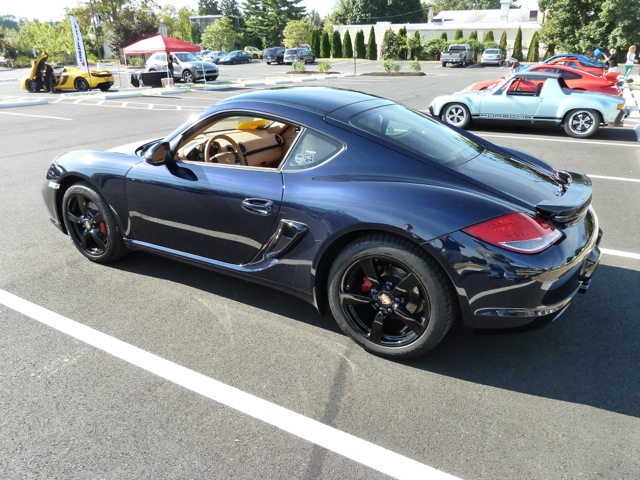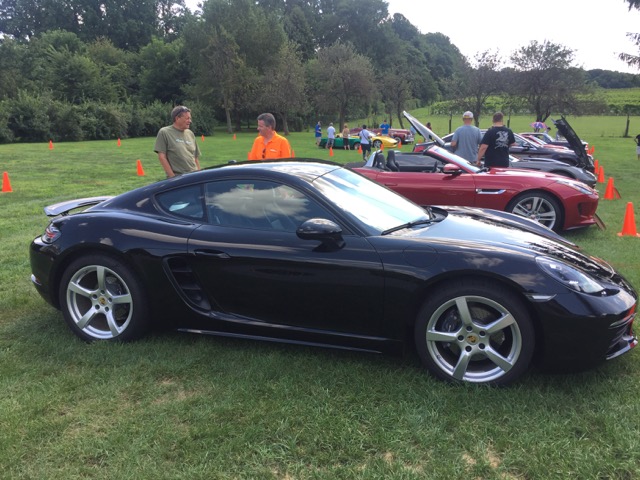Ordinarily I don’t think of myself as being a particularly unique individual. In fact, I consider my personality to be rather reserved – loitering in the shadows more or less. Purchasing a Cayman (my first Porsche), was certainly a departure from this trait. I’ve learned to accept the attention that comes with buying any Porsche product.

My first Cayman
Two years ago, I traded my 2009 Cayman for a 2016 Macan S, and just last month I flipped the Macan for another Cayman (of the 718 variety). I really liked the Macan, but I guess you could say I missed driving my Cayman. So now when I tell you that I am a unique Porsche owner, I do so from two perspectives.
The first is that the Cayman and Macan are on the lower-end of the Porsche pricing strategy – the gateway drug if you will. And I didn’t load them up with many extras, as the manufacturer from Stuttgart would encourage. Actually, my first Cayman was as entry level as they come – not a single option.

My new 718 Cayman at a local car show
Secondly, I might be one of the few Porsche owners to have purchased the original, and then a subsequent model – the second and fourth generation Cayman. Conceptually, they are similar cars of course, but many owners of the original design are conflicted by developments in the 718.
Though the Boxster had already been around for ten years, the Cayman and Boxster models have been gradually aligning with successive releases. And while each generation has improved on paper at least, Porsche appeals to the soul – and many might have felt that the more recent changes did not fit the classic Porsche persona.
The original tailoring of the Boxster (and then the Cayman) borrowed from the influences of its firmly established older sibling, the 911. But the more recent models have developed cleaner lines with a styling that is now entirely their own. This is refreshingly appealing to me, but not necessarily to a classic Porsche enthusiast.
The 718 Cayman is Unique
And as much as I appreciated the silhouette of the original Cayman, there is something completely unique about the 718 that is hard to put into words. While the mid-engine design is the foundation of its soul, side-by-side these two generations couldn’t be more different – though there is undoubtedly a family resemblance.
My first Cayman was always a daily driver and with a little over 75,000 miles on the odometer, being well out of warrantee was making me anxious. The Macan had been out for a year at this point, and confident handling combined with the lightning-quick shifts from the PDK gearbox eased my transition.
If I’m honest however, I always thought I’d get into another Cayman. But when the news came from Stuttgart that Porsche engineers were sharpening their pens with a modernized bevel, I agonized over the rumors. And as the reports became reality, I admit I was somewhat disenchanted.
Then Porsche confirmed that the latest generation Cayman and Boxster lineup would share the 718 moniker, and also be powered by a four-cylinder turbo. As much as I liked the original styling, I was completely captivated by the glorious flat-six that powered it. So to me ,and to many others, this was not pleasant news.

My 2016 Macan S
I think it was then that I stopped reading the press and decided to appreciate the brilliance of my Macan S – a truly inspirational, fun and satisfying sports car with a cavernous hatch. I told anyone who’d listen that next to my Cayman, it was the best handling car I’ve ever owned. And I wasn’t lying.
Falling in Love Again
But then last fall I brought my Macan into the dealership for scheduled service and was poking around the showroom as I always do. I’m not a convertible guy by nature, but when I saw the 718 Boxster from the corner of my eye, I admit to falling immediately for the stimulating profile.
I was mesmerized by the clean lines, aggressive attitude and intimately compelling appeal. It was unmistakably Porsche, but also appeared totally original. My eyes traveled over the tightened haunches and then around to the sharply sculpted rear wing. This was a truly unique design.
And so my research began. I poured over reviews and read every article I could find on the 718 Cayman. As Porsche approached release in the US, I was well versed on its features – and shortcomings. The most difficult and glaring challenge was the transition from the astonishingly popular flat-six to the four-cylinder turbocharged variant.
I Wasn’t Alone
I was not the only one concerned with the reduction of cylinders. The fact that the 718 twins were soundly outperforming their predecessors did not dissuade a swell of objections rising from the Boxster and Cayman communities. The primary concern was the change in exhaust note – essentially from baritone to tenor.
I admit that (initially at least) I was a member of this club. But I rationalized that if I’d successfully evolved from Detroit big blocks to the tone and performance of the Porsche flat-six, it would be pretty insincere of me to dismiss a transition to forced induction on a smaller motor – especially when it cranked out more horsepower.
I finally had the chance to drive a Cayman at a Porsche Experience event sponsored by my dealer. I had already decided that I liked the 718 design even more than my old Cayman, but I was not prepared for the completely new interior when I lowered myself into the bucket seats.
This might just be the best cockpit Porsche has ever produced. Instrument placement and positioning is near perfect. Everything was exactly where it needs to be. Adjust the power seats, fine-tune the searing wheel and column, adjust the mirrors and lock it all into memory – you can tweak it later to your contentment.
I called my sales professional, Erik, when I got back and drove home in a black-on-black 718 Cayman that weekend, leaving him the keys to our Macan S. This was not an easy thing to do. As I mentioned previously, I really liked the Macan. But I have a connection with the Cayman that I cannot deny. I’d have kept both if I could.
What’s Changed?
Comparisons are impossible to ignore, so I’ll give you my impressions of what I think are the most important features and developments. The 718 generation is a progressive improvement on the previous models. These qualities are in no particular order (because they are equally important):
- Design
- Refinement
- Performance
- Ride
Design
I’ve already mentioned the 718 Cayman silhouette had captured my attention in a way that can only be compared to my first Cayman. Where the 2009 was classic and reminiscent of traditional Porsche form, the 718 is like nothing on the road today – there is no mistaking it with anything else, though it is a Porsche to its core.
Refinement
My first Cayman was purposeful, functional and not quite blue-collar. The new model is more refined in almost every aspect. The interior is, as I mentioned, near perfection. The body panels transition from one to the next as if they were machined from a single piece of aluminum. Everything from fitment to the storage areas is subtly enhanced.
Performance
I’ve manually selected gears most of my life, but now I concede this activity to the Porsche PDK transmission. My Macan was fitted with a PDK, and I don’t know if I’ll ever go back to a manual gearbox. Sure, choosing your gears may add to the driving experience, but I can’t help but marvel at the lightning-fast exacting shifts.
The engine does take some getting used to. The sound is certainly different – but if you had never driven a Porsche flat six, your perspective would be dispassionate. In the base Cayman, the turbo kicks in at about 2000 rpm and not quite as smoothly as the 718 Cayman S. But if you squeeze the throttle on launch, you won’t notice discernable lag.
Speaking of forced induction, when the turbocharger does engage, the Cayman goes into warp-speed – far more convincingly than the flat six in my 2009 at even higher revs. Acceleration and torque is astonishing for a car with a smallish motor. But four cylinders never felt this powerfully breathtaking.
Ride
Performance aside, the improvement in ride is the most significant development. Where my first Cayman had always tracked like a go-cart, rough terrain in a bend would toss the back-end laterally like a skipping water bug. The 718 suspension has resolved this issue. Handling is more inspired and the ride and comfort are remarkably improved.
I struggle to balance classic Porsche principles versus progressive engineering. And I admit that I can sit in a car that I dreamed of in my youth, and long for the simplicity it represents. But I can ultimately accept that the evolution of driving is tied directly to technology we could never have comprehended – and to ignore that is to regress.
Similar to the years of development on the 911, I continue to be astonished that Porsche creates automotive hardware so perfectly conceived that it seems sacrilegious to even consider further development. Yet they continue to take the marketing risk and push the engineering envelope – which often involves changes we didn’t ask for.
The 718 models are now the beneficiaries of this approach
Improvements come in many forms, and are not always accepted as progress. Whichever side of the argument you fall on, you’d have to at least admit that Porsche is never satisfied with excellence.
Once more Porsche has demonstrated with the 718 Boxster and Cayman that no matter how many versions you imagine, and how many times your designers and engineers return to the drafting table, even perfection in a Porsche product will continue to be enhanced.
